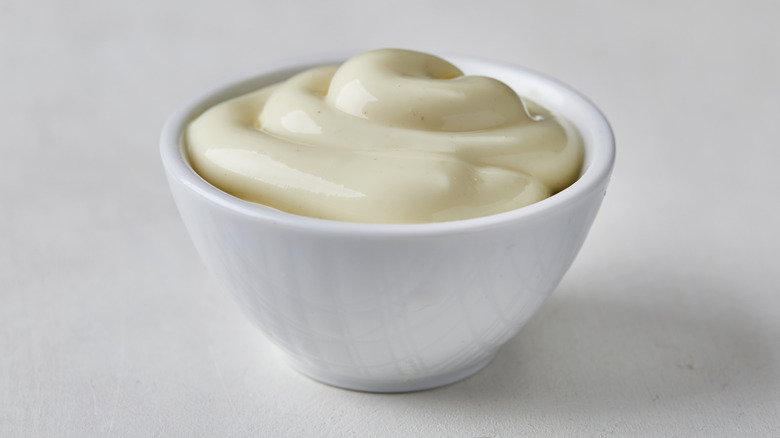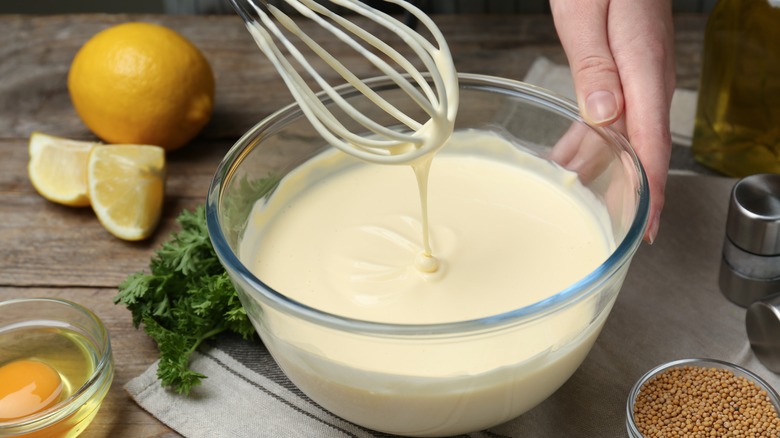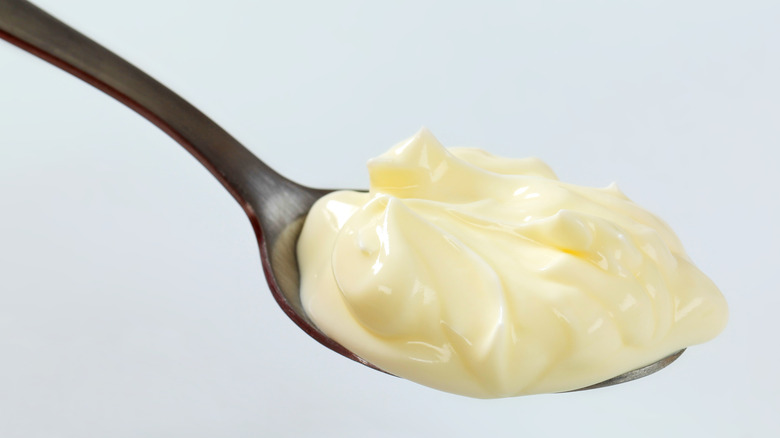Why Lemon Juice Is The Essential First Step In Making Homemade Mayo
Homemade mayonnaise from scratch only takes four ingredients: lemon juice, egg yolks, oil, and salt. It's a simple recipe, and a fast process to blend all of the components together, though it can be tricky to get the emulsion of eggs and oil to cooperate and set properly. If you don't do it carefully, you'll end up with an oily, runny mayo mess instead of a thick, spreadable condiment.
One way to guarantee the best finished product is to drop that lemon juice in first. This will make everything come together much more cohesively than adding the juice in later. It can all be explained by science. The acid in the lemon juice works with the protein inside the egg yolks, breaking them down and getting them prepped to emulsify better with the oil.
With the yolks broken down, the natural emulsifier in them, called lecithin, helps all the ingredients combine harmoniously to thicken the mayo to rich, spreadable perfection. If you can nail it, you may never go back to store-bought mayonnaise again.
What is an emulsification (and why does lemon help)?
So why is it so tricky to make a perfect mayo, and how does lemon juice play such an important role? Emulsification is the answer to both these questions. Different substances won't always blend nicely, and oil is especially tricky to combine smoothly, especially when the other substance has a higher water content. (You know the saying about oil and water.) What the combination needs is an emulsifier — something that's both fat-soluble and water-soluble to bridge the gap between the oil and, in this case, the eggs.
Lecithin is one of the most common natural emulsifiers, and egg yolks contain a large amount of it. The yolks themselves are made of both fat and water, making them an example of oil-water emulsion to begin with. Combining them with outside sources of oil is trickier, though. This is where the lemon comes in: it helps prep the egg yolks so that the lecithin is ready to do its magic, which helps the mixture emulsify when you mix in the oil. It's not just lemon, though: any acid can play this role, including different varieties of vinegar, or even lime juice. It all comes down to flavor preference.
Emusifications can be unstable and fragile, and it doesn't take much for them to break (or separate into the two component substances) again, so every little bit of help to keep the mixture combined will lead to a better, more delicious outcome.
How to make homemade mayonnaise
With the science in mind, you can put those emulsification skills to the test. Making mayo at home goes a little something like this: First, separate the yolks in any eggs you'll be using. One mistake to avoid when making homemade mayo is using refrigerated eggs: you want to use room-temperature eggs for mayo. These eggs won't be cooked in the final recipe, so if you're worried about consuming raw eggs, be sure to use ones that have been pasteurized. (Some say citrus juice can also make raw eggs safer to eat by killing bacteria, though you would need a much higher concentration of acid to egg than this for that process to work.) Combine the egg yolks and lemon juice, and whisk or blend them together.
Next comes the tricky part: stream in a small amount of oil, constantly whisking or blending as you do so. The trick is to keep up a small yet steady stream of oil; go too fast, though, and you risk breaking the emulsion. The steady whisking helps to break the oil down so that it blends better with the water. If you do it properly, the mix should start to look like mayo in no time.
Finally, season your mayo with some salt and any other flavoring add-ins you'd like (garlic, chili powder, etc.), and add a few drops of water if the mayo is too thick for your taste.


